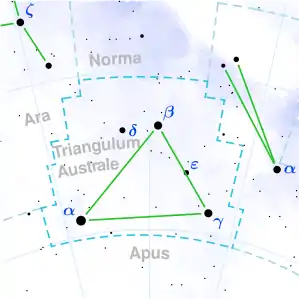WISE 1639−6847
WISE J163940.83−684738.6 (designation is abbreviated to WISE 1639−6847[5], or W1639[1]) is a brown dwarf of spectral class Y0-Y0.5,[1] located in constellation Triangulum Australe (it's the nearest star / brown dwarf in this constellation) at approximately 16 light-years from Earth.[2]
| Observation data Epoch J2000 Equinox J2000 | |
|---|---|
| Constellation | Triangulum Australe |
| Right ascension | 16h 39m 40.83s[1] |
| Declination | −68° 47′ 38.6″[1] |
| Characteristics | |
| Spectral type | Y0-Y0.5[1] |
| Astrometry | |
| Proper motion (μ) | RA: 586±6 mas/yr[2] Dec.: −3101±4 mas/yr[2] |
| Parallax (π) | 211.11 ± 0.56 mas[3] |
| Distance | 15.45 ± 0.04 ly (4.74 ± 0.01 pc) |
| Other designations | |
| Database references | |
| SIMBAD | data |
 WISE 1639−6847 Location of WISE 1639−6847 in the constellation Triangulum Australe | |
Discovery
WISE 1639−6847 was discovered in 2012 by C. G. Tinney et al. from data, collected by Wide-field Infrared Survey Explorer (WISE) Earth-orbiting satellite — NASA infrared-wavelength 40 cm (16 in) space telescope, which mission lasted from December 2009 to February 2011.
In 2012 Tinney et al. carried out follow-up observations of WISE 1639−6847 using the FourStar infrared mosaic camera mounted on the 6.5 m Magellan Baade telescope at Las Campanas Observatory, Chile (on 2012 May 10–11 (UT)); and spectroscopy using the Folded-port Infrared Echellette (FIRE) also mounted on the 6.5 m Magellan Baade telescope (on 2012 July 10 (UT)).
In 2012 Tinney et al. published a paper in The Astrophysical Journal, where they presented discovery of a newfound by WISE Y-type brown dwarf WISE 1639−6847 (the only brown dwarf discovery, presented in the article): the paper was accepted for publication on 20 September 2012, submitted to arXiv on 27 September 2012, and published in November 2012.[1]
Physical properties
WISE 1639−6847 has absolute magnitude in J-band 22.14 ± 0.22.[1]
References
- Tinney, Chris G.; Faherty, Jacqueline K.; Kirkpatrick, J. Davy; Wright, Edward L.; Gelino, Christopher R.; Cushing, Michael C.; Griffith, Roger L.; Salter, Graeme (2012). "WISE J163940.83–684738.6: A Y Dwarf Identified by Methane Imaging". The Astrophysical Journal. 759 (4): 60. arXiv:1209.6123. Bibcode:2012ApJ...759...60T. doi:10.1088/0004-637X/759/1/60. S2CID 119231938.
- Tinney, C. G.; Faherty, Jacqueline K.; Kirkpatrick, J. Davy; Cushing, Mike; Morley, Caroline V.; Wright, Edward L. (2014). "The Luminosities of the Coldest Brown Dwarfs". The Astrophysical Journal. 796 (1): 39. arXiv:1410.0746. Bibcode:2014ApJ...796...39T. doi:10.1088/0004-637X/796/1/39. S2CID 9038276.
- Fontanive, C.; Bedin, L. R.; Bardalez Gagliuffi, D. C. (February 2021). "The Y dwarf population with HST: unlocking the secrets of our coolest neighbours - I. Overview and first astrometric results". Monthly Notices of the Royal Astronomical Society. 501 (1): 911–915. arXiv:2011.13873. Bibcode:2021MNRAS.501..911F. doi:10.1093/mnras/staa3732. S2CID 227208804.
- Golovin, Alex; Reffert, Sabine; Just, Andreas; Jordan, Stefan; Vani, Akash; Jahreiß, Hartmut (November 2022). "The Fifth Catalogue of Nearby Stars (CNS5)". Astronomy & Astrophysics. 670: A19. arXiv:2211.01449. Bibcode:2023A&A...670A..19G. doi:10.1051/0004-6361/202244250. Catalogue can be accessed here.
- Dupuy, T. J.; Kraus, A. L. (2013). "Distances, Luminosities, and Temperatures of the Coldest Known Substellar Objects". Science. 341 (6153): 1492–5. arXiv:1309.1422. Bibcode:2013Sci...341.1492D. doi:10.1126/science.1241917. PMID 24009359. S2CID 30379513.


